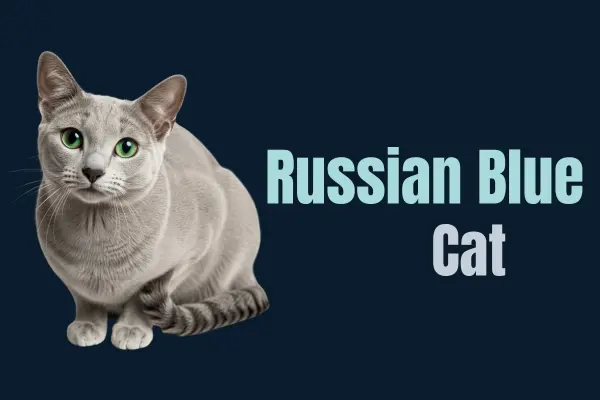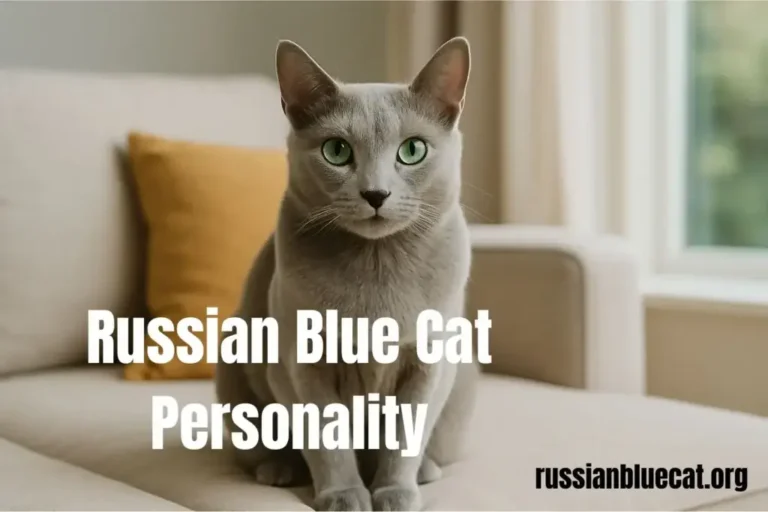Russian Blue Cat History: 7 Fascinating Facts That Will Amaze You

Introduction
The Russian Blue Cat History is the most intriguing tale in the world of cats. These cats, with their glimmering silver-blue coats and jewel-toned green eyes, are much more than elegant companions. Their past is entwined with legends of kingship, stories of mariners, and the frozen Russian north. The reason their past is so intriguing is the way it reflects the characteristics we can still observe in them today courage, refinement, and subdued loyalty. Learning about their history from enigmatic Russian ports to world fame allows us to not only admire their looks but also tap into the centuries of adoration that have molded this dignified breed.
Origin of the Russian Blue Cat
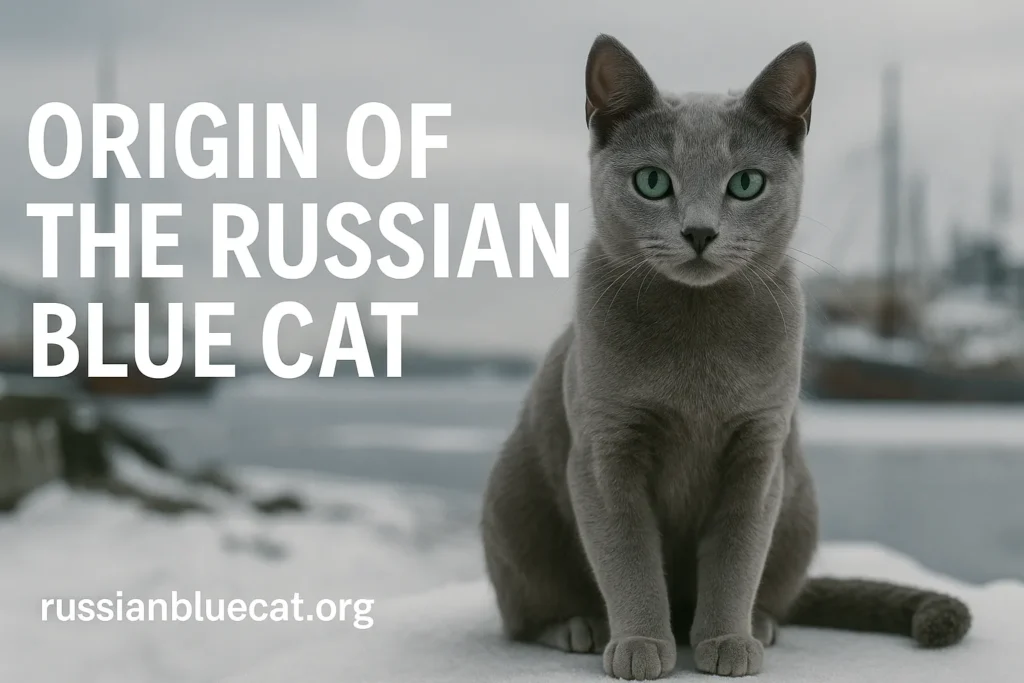
The earliest pages of the Russian Blue Cat History lie in the chilly northern part of Russia, specifically the port town of Arkhangelsk. This harsh, cold environment probably contributed to the evolution of their double-layered, thick coats, which were meant to protect them against harsh winter gusts. These cats were taken aboard by sailors from the local area who traveled between Russia and the rest of Europe, trading there. The cats were as much appreciated for their company as for their ability to keep vessels rodent-free. These travels established the basis for the spread of the breed throughout the globe.
Folktales and Legends
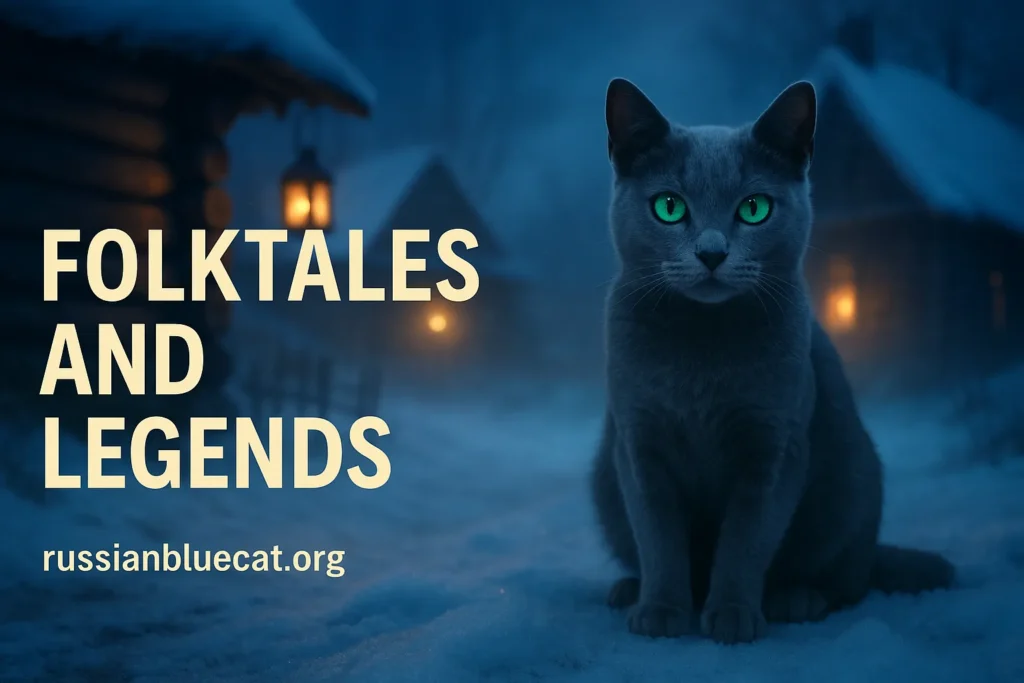
Russian folklore played an important part in the popularity of the breed. Stories dating back to the 17th and 18th centuries tell of “blue-gray cats” possessing supernatural attributes. A few legends state that they were guardians of evil spirits, while others profess their dramatic coat color represented prosperity and riches. Aristocrats are said to have kept them in royal nurseries because they believed that Russian Blues would protect children from harm. These myths increased their prestige and afforded the cats an aura of good luck which still lingers around them today. Have you checked our detailed guide on Russian Blue Cat Facts.
Spread Across Europe
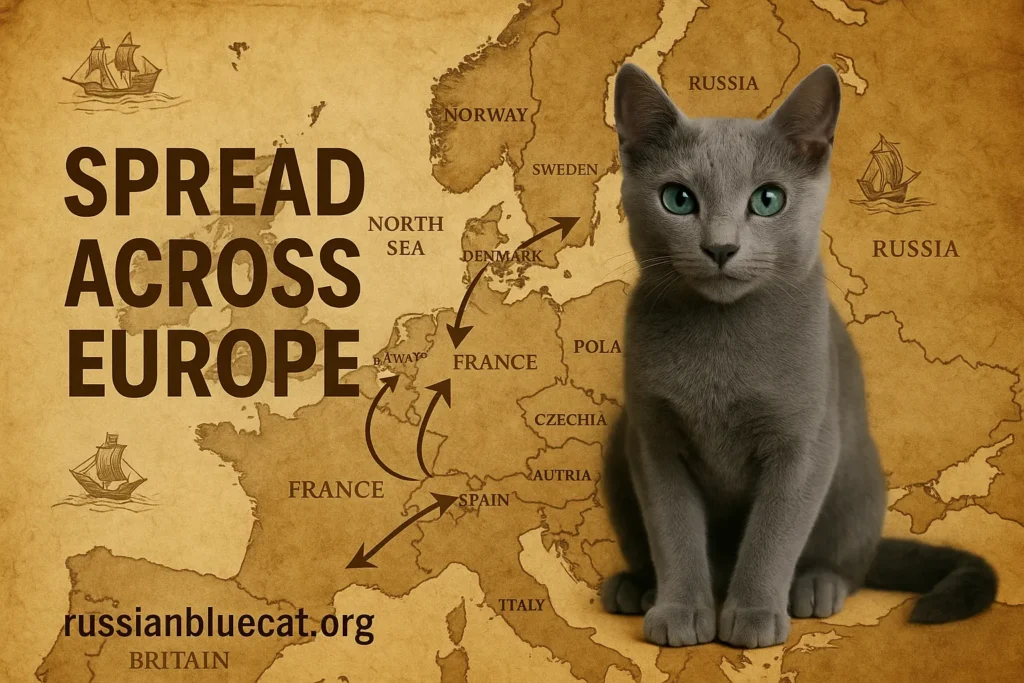
The Russian Blue Cat History expanded beyond Russia in the mid-1800s, when sailors brought them to England and other European ports. Their first recorded appearance outside Russia was in 1875 at the Crystal Palace Cat Show in London, where they were introduced under the name “Archangel Cats,” a nod to Arkhangelsk.
Despite being vaunted for their distinctive looks, they originally struggled against the British Shorthair, which had a coat color not dissimilar. But the Russian Blue soon asserted its own distinctiveness with its more delicate bone structure, bright green eyes, and refined airs. Breeders quickly saw that this cat needed to be considered as a breed in itself, and work began to accentuate and define its characteristics.
Recognition as a Distinct Breed
By the early 20th century, Russian Blue fans and breeders in Britain and Scandinavia were establishing the Russian Blue as a specific breed. They were doing this to maintain three hallmarks: the dazzling, soft double coat; the emerald almond-shaped eyes; and the slender, refined body.
The start of World War II threatened the breed. Populations were significantly reduced, and in a bid to preserve them, breeders crossed Siamese cats with Russian Blues. This action maintained the breed but changed their appearance, bringing in features such as a more angular body type and varying eye shape. It wasn’t until the 1960s and 1970s that committed breeders, especially in Scandinavia and the U.S., painstakingly re-established the classic appearance by reintroducing Russian bloodlines. This endeavor made sure the breed kept its historic appeal and conformed to contemporary breeding practices.
Role in Russian Culture
The Russian Blue was not merely one more housecat in Russia it was regarded as a symbol of prosperity and elegance. Russian nobility and rich families tended to keep them as cherished companions. Their even-tempered nature and hypoallergenic properties also made them favorites among high society. There are even stories that Russian czars would have admired the breed, keeping them in royal palaces not just for their looks but also for their dignified, quiet nature.
Their connection with prosperity and good luck made them popular, and their myths as spiritual guardians solidified their position in Russian cultural heritage. For Russians, keeping a Russian Blue at home was believed to instill harmony and tranquility in the family.
Russian Blue Cat in America
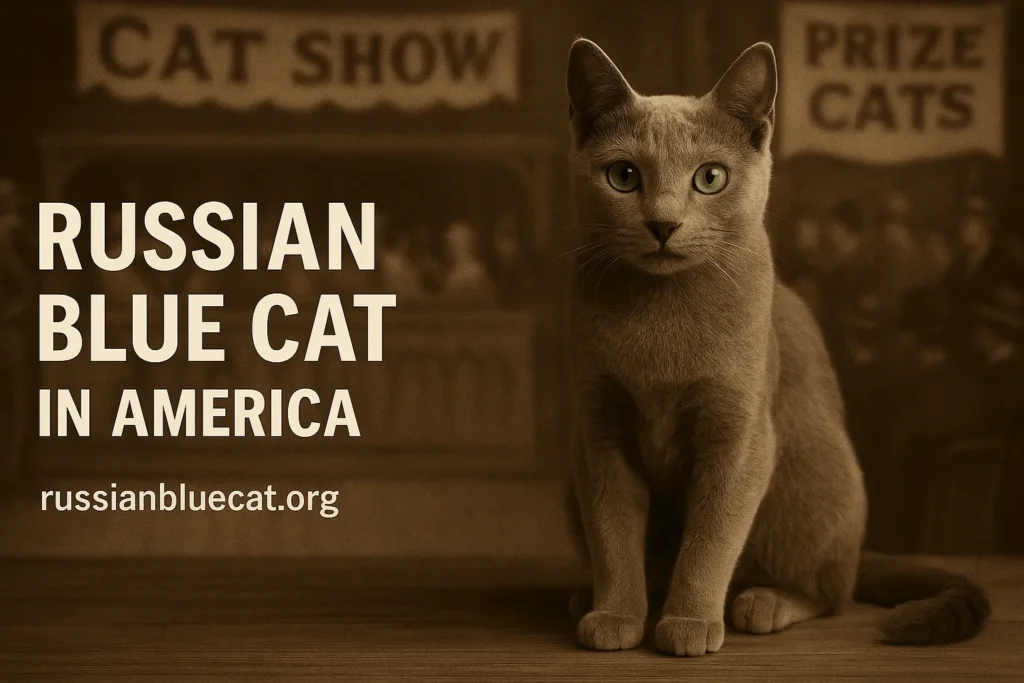
The breed traveled across the Atlantic in the early 20th century, where it established a new reputation within the United States. It was soon recognized by prominent organizations, such as the Cat Fanciers’ Association (CFA), which currently holds the official breed standard. You can view the CFA’s standards and historical information on the Russian Blue here, making it an invaluable resource for owners and enthusiasts alike.
In the United States, the Russian Blue became admired for its elegance combined with usability. Families appreciated the fact that these cats were friendly but not high-maintenance, forming a very strong bond with their owners and being politely aloof with visitors. Their hypoallergenic nature also meant that they were an ideal pet for families with mild allergies to cats. In the 1970s and 1980s, Russian Blues had firmly become one of the most popular pedigree breeds in the U.S.
Historical Characteristics and Their Impact Today
What is most interesting about the Russian Blue Cat History is the way its history has directly contributed to the breed’s present character:
- Survival in Severe Environments: Their double coat, previously essential to keeping them warm in freezing winters of Arkhangelsk, now renders them among the softest and most sumptuous of felines on the planet.
- Voyages with Sailors: Exposure to varying surroundings provided them with adaptability, and they were surprisingly suited to apartment living as well as to larger houses.
- Association with Nobility: Selective breeding among nobles highlighted their refinement, quiet nature, and faithful nature, characteristics which still identify them today.
This ancient combination of survival and refinement produced a cat that is not just beautiful to look at but also intensely attached to humans in a special, noble fashion.
Legends of Good Fortune
Russian Blues have long been referred to as “lucky cats” throughout history. In Russian folklore, the bride and groom may be gifted with a Russian Blue kitten as part of their wedding gift, which represents prosperity and happiness. Families thought their silver coats reflected light and kept negativity at bay. These attitudes accompanied the breed to Western Europe, where they were prized not only for their looks but also for the feeling of calm they introduced into the home. Today, many owners sense that a Russian Blue brings a calm, positive vibe to the home.
The Russian Blue in Modern Breeding
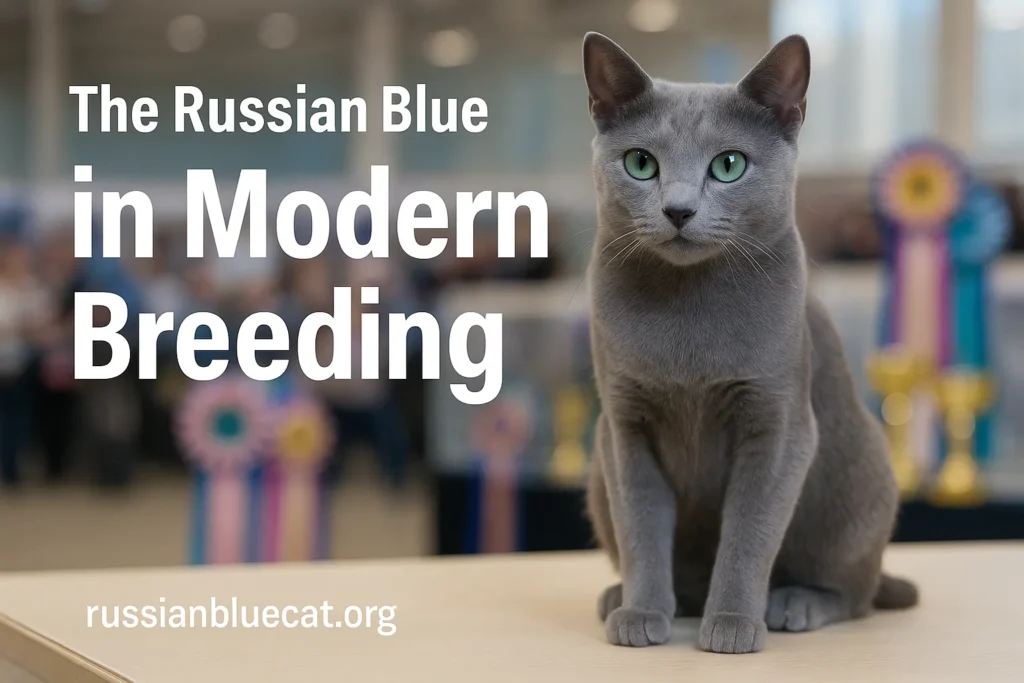
Preservation Efforts
Modern-day breeders are very dedicated to upholding the Russian Blue’s traditional characteristics. Efforts are aimed at keeping their radiant coat, uniform emerald-green eye color, and overall health in check. Genetic diversity is closely observed to keep the breed healthy and robust.
Global Popularity
Across Europe to Asia and the Americas, Russian Blues are always among the most respected pedigree cats. They are a staple at cat shows and their appeal in advertising and the media further boosted their prestige. Intelligent and gentle, they make the perfect companion for families and individuals who desire a cat with both history and poise behind it.
Main Historical Landmarks
- Pre-1800s: Origin in northern Russia’s Arkhangelsk, modified for cold climates.
- 1800s: Brought to Britain and Western Europe by sailors.
- 1875: Exhibited at Crystal Palace in London as “Archangel Cats.”
- 1900s: Separately recognized throughout Europe.
- WWII Era: Population reduced; survival due to crossbreeding.
- 1960s–70s: Restoration of the classic look by breeders globally.
- Today: Recognized worldwide and appreciated for elegance, health, and heritage.
Why the History Matters for Owners
For contemporary cat owners, knowing the Russian Blue Cat History isn’t merely a fun tidbit—it’s a glimpse into what makes the breed tick. Their desire for routine, gentle demeanor, and profound loyalty owe their existence to centuries of adaptation and selective breeding. Through an understanding of their history, owners can gain greater appreciation of their idiosyncrasies and create the proper environment for them. It also solidifies the connection, reminding us that every Russian Blue contains within it the heritage of sailors, czars, breeders, and families who loved them long ago.
Frequently Asked Questions (FAQs)
Conclusion
The Russian Blue Cat History is an inspiring odyssey covering centuries, continents, and cultures. From the icy docks of Arkhangelsk to imperial Russian palaces, from European exhibitions to domestic American homes, Russian Blues have left their mark wherever they went. Their ability to endure periods of adversity, their connection to good fortune legends, and their classical beauty all add up to their standing as one of the most unique cat breeds alive today.
By learning about their history, owners today do not only acquire knowledge but a sense of belonging as well to their pets. Russian Blues are not just handsome companions—they are living art forms, bearing with them the myths, traditions, and affection of countless generations.
